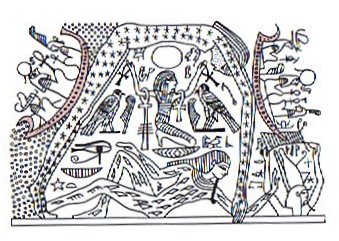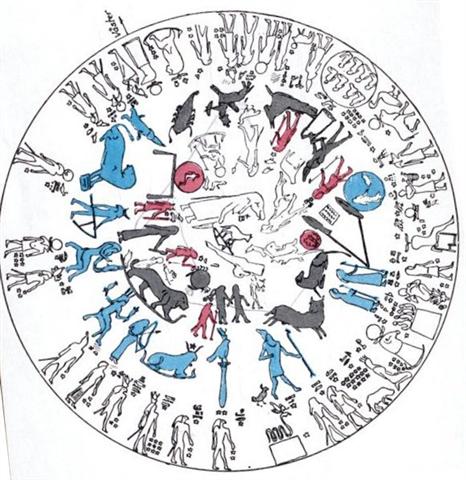4 In the sky roof Hydra is a long constellation 'below the the belt' (south of the equator) and medieval painters tended to picture the Serpent of Eden as a female in a vain attempt from the Church to hide the obvious resemblance to a penis. But when Sun has reached his full stature he is ready to be initiated into the mystery of life as expressed by the other sex (cfr at Orientation): ... At noon, when Sun has reached manhood, he is strong. Moving from a.m. to p.m. is like going through a door, he must be reborn at noon, he must go through an initiation, his old self must be ritually 'killed' ... The location of Serpent in high summer and in 'midair' so to say should make us remember the 'feather' god Schu (cfr at Kiore):  ... The god Schu, who is reclining at the bottom, has his left foot hidden. He personifies, they say, the air between sky and earth, and his body is covered with feathers (schut) as a sign of this ... ... In the Egyptian picture we can probably identify the right raised up knee of Schu as the path of Sun in summer ... It is similar to the sign at bottom front of tagata in Ga1-5:
The couple of birds who have found each other (in Ga3-18) has an empty space sign between them which can be interpreted as the distance between the male sky roof (the bird at left) and the female earth (the bird at right) in high summer:
The Feathered Serpent (Sun, cfr at Vero) has feathers to indicate his potentiality to bridge the gap between Sky and Earth. Feathers allude not only to the bright feather plumes of such birds as were highly appreciated for the attires of kings but also to the superhuman power of birds to quickly move vertically, cfr at Hiro: ... In the deep night before the image [of Lono] is first seen, there is a Makahiki ceremony called 'splashing-water' (hi'uwai). Kepelino tells of sacred chiefs being carried to the water where the people in their finery are bathing; in the excitement created by the beauty of their attire, 'one person was attracted to another, and the result', says this convert to Catholicism, 'was by no means good' .... The round Dendera zodiac has no obvious Serpent constellation (unless we interpret as a snake the 'boat' in which Leo is standing) but there is a vertically undulating snake outside the round zodiac, above a 'square':
It comes just after Orion, the great blue walking figure with a staff (and with his right arm forming a triangle), obviously the same constellation as that named True Shepherd of Anu (the sky god) in the Babylonian zodiac. The serpent has a crown and is close to the right foot of Orion. South of the equator this evidently was remembered as the place in the sky for summer solstice (although it was winter solstice down on earth). However, Betelgeuze is not the right foot but rather the right hand (rima), with Rigel diametrically opposed and 10 days earlier as the left foot:
In between Rigel and Betelgeuze lie the 3 'stones' (Tautoru) which support the new 'fire' (cfr at Parehe):  If we count the distance from Betelgeuze to Alphard it is 143 - 89 = 54 days:
The name Ana-heu-heu-po requires an explanation. In my list of Polynesian words the item at heu is not very illuminating, unless we try to use my introduction to the subject above:
The 'body hair' (heuheu) does not refer to the hair on a human body. Instead, I think, it alludes to the 'feathers' of the Serpent. Heuheu should be the opposite of heu = to separate. Thus heuheu is to join, and under my item kiri (skin) I found a kind of confirmation:
Down (small new feathers) is what should characterize a fiery serpent down below. |
|||||||||||||||||||||||||||||||||||||||||||||||||||||||||||||||||||||||||||||||||||||||







